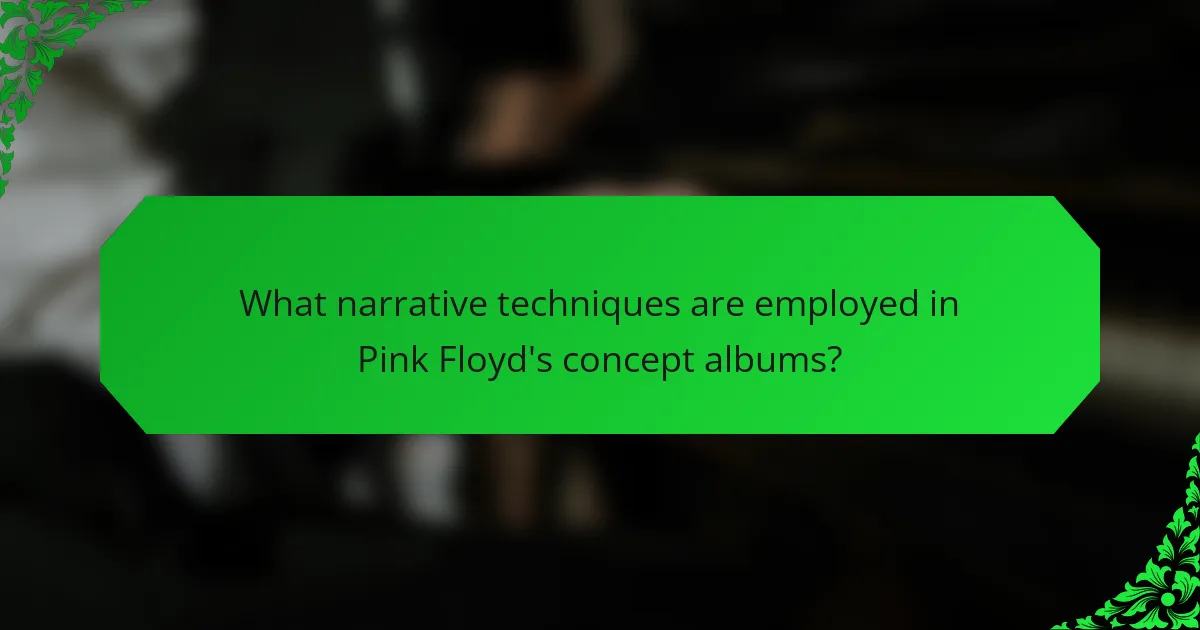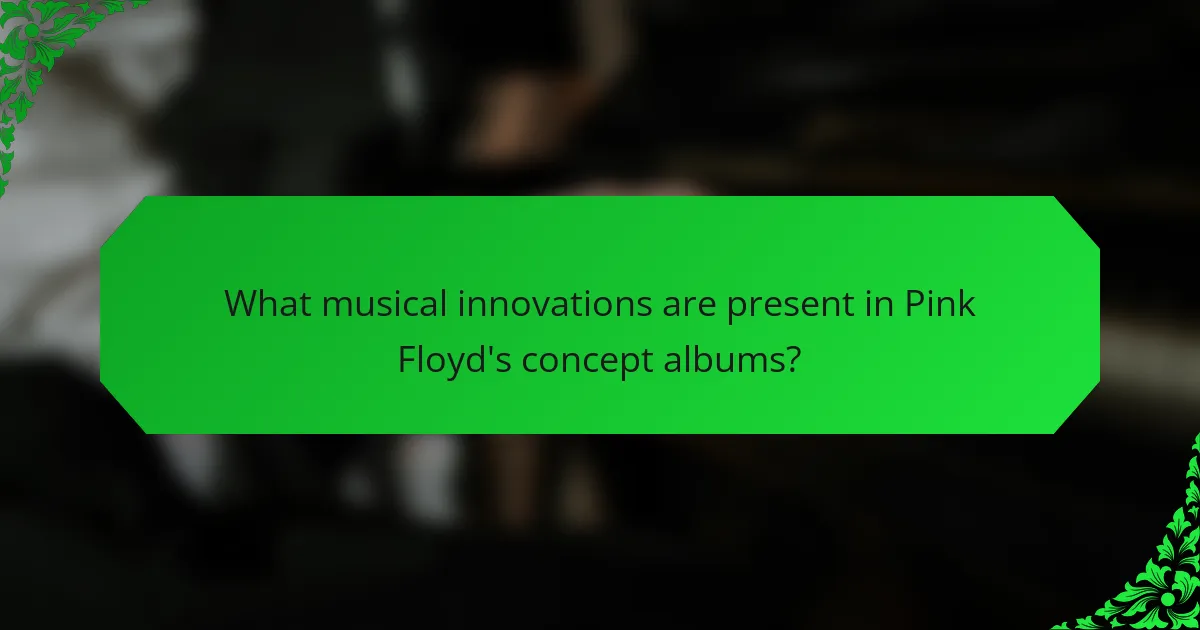Pink Floyd’s concept albums are thematic works that explore cohesive narratives and specific ideas, with notable examples including “The Dark Side of the Moon,” “Wish You Were Here,” and “The Wall.” These albums employ various narrative techniques such as continuous storylines, recurring musical motifs, and character development, enhancing emotional connections with listeners. Additionally, Pink Floyd’s musical innovations, including extended instrumental passages, sound collage techniques, and the use of synthesizers, contribute to a unified artistic vision. The integration of spoken word and dynamic contrasts further deepens the storytelling experience, solidifying the band’s influential role in music history.

What are Pink Floyd’s Concept Albums?
Pink Floyd’s concept albums are thematic works that tell a cohesive story or explore a specific idea. Notable examples include “The Dark Side of the Moon,” which examines mental health and existential themes. “Wish You Were Here” reflects on the music industry and loss. “The Wall” tells the story of a character’s isolation and emotional struggles. Each album uses musical innovations to enhance the narrative. The band integrates sound effects and progressive rock elements to create immersive experiences. Their concept albums are critically acclaimed and influential in music history.
How do Pink Floyd’s concept albums differ from traditional albums?
Pink Floyd’s concept albums differ from traditional albums by presenting a unified narrative and thematic continuity. Traditional albums often consist of standalone songs without a cohesive story. In contrast, Pink Floyd’s works like “The Wall” and “Dark Side of the Moon” explore complex themes such as alienation, mental health, and societal issues. These albums use musical motifs and lyrics that interconnect throughout the tracks. For example, “The Wall” tells a story of a character’s descent into isolation. Additionally, the use of sound effects and dialogue enhances the storytelling aspect. This approach creates an immersive experience that engages listeners on multiple levels.
What defines a concept album in the context of Pink Floyd?
A concept album in the context of Pink Floyd is defined by a cohesive narrative or theme that spans the entire album. This structure often involves interconnected songs that explore complex ideas and emotions. Pink Floyd’s albums frequently incorporate progressive rock elements, blending music and storytelling. For example, “The Dark Side of the Moon” addresses themes of mental illness and existentialism. The tracks flow seamlessly into one another, enhancing the overall narrative experience. Additionally, the use of sound effects and spoken word segments contributes to the immersive quality of their concept albums. “The Wall” exemplifies this with its exploration of isolation and personal struggle through a rock opera format. These characteristics distinguish Pink Floyd’s approach to concept albums within the music industry.
What are the key characteristics of Pink Floyd’s concept albums?
Pink Floyd’s concept albums are characterized by a cohesive narrative structure and thematic continuity. Each album typically explores complex themes such as alienation, mental health, and existentialism. The music is often interlinked, creating a seamless listening experience. Instrumentation plays a significant role, with innovative soundscapes and effects enhancing the storytelling. Lyrics are often poetic, reflecting deep philosophical ideas. Additionally, visual elements like album artwork and live performances contribute to the overall concept. Notable examples include “The Dark Side of the Moon” and “The Wall,” both of which exemplify these characteristics through their storytelling and musical innovation.
Why are Pink Floyd’s concept albums significant in music history?
Pink Floyd’s concept albums are significant in music history because they pioneered the integration of narrative and thematic continuity in rock music. Their albums, such as “The Dark Side of the Moon” and “The Wall,” explore complex themes like mental health, societal issues, and personal alienation. These works challenged traditional song structures by presenting a cohesive story throughout the album. “The Dark Side of the Moon” remained on the Billboard charts for 741 weeks, illustrating its cultural impact. Additionally, Pink Floyd’s use of innovative sound techniques and studio effects set new standards in music production. Their visual presentations, including elaborate stage shows, transformed live performances into immersive experiences. This combination of storytelling, musical innovation, and theatricality has influenced countless artists and genres, solidifying Pink Floyd’s legacy in music history.
How have Pink Floyd’s albums influenced the genre of progressive rock?
Pink Floyd’s albums have significantly influenced the genre of progressive rock by pioneering concept albums and innovative soundscapes. Their work, particularly “The Dark Side of the Moon,” integrated complex themes and seamless transitions between tracks. This album, released in 1973, is often regarded as a benchmark for progressive rock due to its exploration of mental health and existentialism.
Additionally, “Wish You Were Here” and “The Wall” expanded narrative techniques in music, telling cohesive stories throughout their tracks. These albums utilized elaborate instrumentation and production techniques, setting a standard for future progressive rock bands. The incorporation of synthesizers and non-traditional song structures in their music further pushed the boundaries of the genre.
Pink Floyd’s emphasis on creating immersive listening experiences has influenced countless artists and shaped the evolution of progressive rock. Their legacy is evident in the works of bands such as Genesis and Yes, who adopted similar thematic and musical approaches.
What impact did Pink Floyd’s concept albums have on other artists?
Pink Floyd’s concept albums significantly influenced other artists by popularizing the format in rock music. Their album “The Dark Side of the Moon” set a precedent for thematic coherence and sonic experimentation. This inspired bands like Genesis and Yes to explore similar narrative structures in their work. The use of extended compositions and seamless transitions became a hallmark of progressive rock. Additionally, artists such as Radiohead and Tool have cited Pink Floyd’s atmospheric soundscapes as a key influence on their musical style. The incorporation of visual elements in live performances also encouraged other musicians to enhance their concerts with multimedia experiences. Pink Floyd’s approach to storytelling through music continues to resonate across genres, shaping the evolution of artistic expression in popular music.

What narrative techniques are employed in Pink Floyd’s concept albums?
Pink Floyd’s concept albums employ various narrative techniques to convey their themes. One key technique is the use of a continuous storyline. This approach allows the albums to flow seamlessly from one track to another. Another technique is the integration of recurring musical motifs. These motifs create a sense of unity throughout the album. Additionally, Pink Floyd utilizes character development within their lyrics. This technique helps listeners connect emotionally with the narrative. The use of sound effects and atmospheric elements also enhances storytelling. For example, “The Wall” features sounds that reflect the protagonist’s mental state. Furthermore, the albums often incorporate allegorical and symbolic elements. These aspects deepen the thematic content and invite interpretation. Overall, these narrative techniques contribute to the immersive experience of Pink Floyd’s concept albums.
How does storytelling play a role in Pink Floyd’s music?
Storytelling is central to Pink Floyd’s music, particularly in their concept albums. Each album often follows a cohesive narrative that explores themes of alienation, mental health, and societal issues. For instance, “The Wall” tells the story of a rock star’s descent into isolation and madness. This narrative is supported by both lyrics and musical transitions that enhance the emotional impact. Additionally, “Wish You Were Here” reflects on absence and loss, using storytelling to evoke personal connections. The band’s use of soundscapes and instrumental interludes further enriches the storytelling experience. Overall, Pink Floyd’s music integrates storytelling to create profound, immersive experiences for listeners.
What themes are commonly explored in Pink Floyd’s narratives?
Common themes in Pink Floyd’s narratives include alienation, mental illness, and the critique of societal norms. The band often explores the human experience and emotional struggles. Their lyrics reflect feelings of isolation, particularly in songs like “Comfortably Numb.” Mental health is a prominent theme, influenced by band member Syd Barrett’s struggles. The critique of war and its consequences appears in albums like “The Wall.” Additionally, the loss of innocence and the passage of time are recurring motifs throughout their work. These themes contribute to the band’s lasting impact on music and culture.
How do the lyrics contribute to the overall story in the albums?
The lyrics in Pink Floyd’s albums serve as a narrative device that drives the story forward. They provide context and depth to the musical themes. Each song’s lyrics often reflect the emotional journey of the characters. For example, in “The Wall,” the lyrics explore isolation and alienation. This thematic exploration enhances the listener’s understanding of the protagonist’s struggles. Additionally, the lyrics often connect different songs, creating a cohesive narrative arc. The storytelling aspect is further emphasized through recurring motifs and phrases. This lyrical approach allows listeners to engage with the album on a deeper level. Overall, the lyrics are integral to the albums’ conceptual framework and storytelling.
What is the significance of character development in their albums?
Character development in Pink Floyd’s albums is significant because it enhances the narrative depth. The characters often reflect complex emotions and societal issues. This development allows listeners to connect personally with the themes. For example, in “The Wall,” the character Pink embodies isolation and trauma. His journey illustrates the impact of fame and personal loss. This connection makes the music more relatable and impactful. Additionally, character arcs provide a cohesive structure to the albums. They guide listeners through the overarching narrative, enriching the listening experience. Ultimately, character development is essential for conveying the intended messages and emotions.
Who are the key characters featured in Pink Floyd’s concept albums?
The key characters featured in Pink Floyd’s concept albums include Pink, the protagonist of “The Wall.” Pink represents isolation and the struggle against personal demons. Another character is the Teacher, who symbolizes authority and control in “The Wall.” Additionally, in “Animals,” characters are based on animal archetypes: the Dog, the Pig, and the Sheep represent different societal roles. In “Wish You Were Here,” the character Syd Barrett embodies loss and the effects of mental illness. These characters serve to convey deeper themes of alienation, societal critique, and personal experience throughout Pink Floyd’s narrative-driven albums.
How do these characters enhance the listener’s experience?
Characters in Pink Floyd’s concept albums enhance the listener’s experience by providing a narrative framework. This framework allows listeners to engage with the music on a deeper emotional level. Each character embodies specific themes, such as alienation, madness, and existentialism. For instance, the character Pink in “The Wall” represents isolation and the impact of fame. This character’s journey resonates with listeners who may feel similarly disconnected. Additionally, the varied perspectives of these characters create a multi-dimensional storytelling experience. This complexity invites listeners to reflect on their own lives and emotions. Moreover, the interplay between music and character development enhances the overall atmosphere of the albums. The use of dialogue and sound effects further immerses the audience in the narrative. Overall, these characters serve as conduits for exploring profound themes, enriching the listening experience.

What musical innovations are present in Pink Floyd’s concept albums?
Pink Floyd’s concept albums feature several musical innovations. These include the use of extended instrumental passages. Such passages create a cohesive narrative flow throughout the albums. Additionally, they employ sound collage techniques. This involves layering various audio effects and samples to enhance the storytelling.
The band also integrates synthesizers prominently in their compositions. This use of technology expanded the sonic palette available to them. Moreover, their albums often include thematic continuity across tracks. This approach allows listeners to experience a unified artistic vision.
Another innovation is the incorporation of spoken word and dialogue. This technique adds depth to the lyrical content and narrative structure. Pink Floyd’s use of dynamic contrasts also stands out. They shift between soft, melodic sections and powerful, climactic moments.
These innovations collectively redefine the boundaries of rock music. They emphasize the importance of atmosphere and emotion in storytelling.
How did Pink Floyd incorporate technology into their music production?
Pink Floyd incorporated technology into their music production through innovative recording techniques and equipment. They utilized multi-track recording to layer sounds and create complex compositions. The band was known for using synthesizers, particularly the EMS Synthi A and the Minimoog, to generate unique electronic sounds. They also employed tape manipulation techniques, such as reverse playback and tape loops, to enhance their music’s texture. The use of sound effects, like the cash register in “Money,” showcased their creative approach to audio. Additionally, they embraced advancements in studio technology, including the use of the quadrophonic sound system in live performances. Their album “The Dark Side of the Moon” exemplifies these technological integrations, featuring precise sound engineering and innovative production methods that have influenced music production standards.
What unique instruments and sounds are featured in their albums?
Pink Floyd’s albums feature unique instruments and sounds that enhance their musical innovations. They are known for using the synthesizer extensively, particularly the EMS Synthi AKS. This instrument contributes to their distinctive soundscapes. The band also incorporates the use of the Mellotron, which adds orchestral textures to their music. Additionally, they utilize tape loops and sound effects, creating immersive auditory experiences. Notably, the use of the slide guitar by David Gilmour adds a unique tonal quality. The incorporation of found sounds and spoken word elements further distinguishes their albums. Each of these elements contributes to the atmospheric depth characteristic of Pink Floyd’s work.
How did their approach to sound design set them apart from contemporaries?
Pink Floyd’s approach to sound design distinguished them from contemporaries through innovative use of studio technology. They utilized multi-track recording to layer sounds creatively. This technique allowed for complex sonic textures that were not common in their era. They incorporated non-musical elements, such as spoken word and environmental sounds, enhancing narrative depth. Their experimentation with synthesizers and effects created unique soundscapes. The album “The Dark Side of the Moon” exemplifies this with its seamless transitions and intricate sound effects. This level of detail in sound design contributed to immersive listening experiences. Their pioneering methods influenced future generations of musicians and producers.
What role does instrumentation play in creating the atmosphere of their albums?
Instrumentation plays a crucial role in creating the atmosphere of Pink Floyd’s albums. The band’s use of diverse instruments enhances emotional depth and thematic expression. Unique sounds from synthesizers and guitars contribute to a surreal and immersive experience. For example, the use of the Moog synthesizer in “Wish You Were Here” creates a haunting ambiance. Additionally, the combination of acoustic and electric instruments adds layers to the music. This layering allows for dynamic contrasts, reinforcing the narrative arcs. The atmospheric qualities of tracks like “Comfortably Numb” are largely due to instrumental arrangements. Overall, instrumentation is integral to the band’s ability to evoke specific moods and feelings in their concept albums.
How do different musical styles contribute to the narrative of the albums?
Different musical styles enhance the narrative of Pink Floyd’s albums by creating distinct emotional landscapes. Each style evokes specific feelings that align with the themes of the songs. For instance, progressive rock elements build complex soundscapes that reflect the intricacies of the human experience. The use of ambient music in tracks like “The Great Gig in the Sky” conveys a sense of transcendence and introspection. Additionally, the incorporation of blues influences in songs like “Breathe” adds a layer of melancholy and longing. These stylistic choices support the storytelling by matching the musical tone to the lyrical content. This alignment deepens listener engagement and enhances the overall narrative coherence. Pink Floyd’s experimentation with various genres ultimately enriches the listener’s journey through their concept albums.
What is the importance of musical transitions within the concept albums?
Musical transitions are crucial in concept albums as they create coherence and continuity. They link different tracks, enhancing the narrative flow of the album. This technique allows the listener to experience the album as a unified work rather than a collection of separate songs. Pink Floyd, known for their concept albums, effectively used transitions to convey thematic elements. For instance, in “The Dark Side of the Moon,” seamless transitions between tracks amplify emotional impact. These transitions can also reflect changes in mood or perspective, enriching the storytelling. Overall, they serve to immerse the listener in the album’s overarching concept.
What practical tips can listeners use to appreciate Pink Floyd’s concept albums?
To appreciate Pink Floyd’s concept albums, listeners should engage with the music actively. Start by listening to the albums in their entirety without interruptions. This approach allows for a full understanding of the narrative flow. Pay attention to the lyrics, as they often convey deep themes and stories. Familiarize yourself with the historical context of the albums. Understanding the band’s influences and the socio-political climate can enhance appreciation. Additionally, explore the instrumental sections. These often carry emotional weight and contribute to the overall atmosphere. Finally, consider listening to live performances. They can provide a different perspective on the music and its impact.
Pink Floyd’s concept albums are thematic works that present cohesive narratives and explore complex ideas, with notable examples including “The Dark Side of the Moon,” “Wish You Were Here,” and “The Wall.” These albums differ from traditional collections of standalone songs by integrating interconnected tracks that delve into themes such as mental health, alienation, and societal critique. The article examines the key characteristics of these albums, including narrative techniques, character development, and musical innovations that enhance storytelling. Additionally, it highlights the significance of Pink Floyd’s work in music history and its influence on the progressive rock genre and other artists.
